Setup Address Book and Forms
In this chapter
·Publish Archive Manager Forms
Setup up the Address Book
You must import the Microsoft Exchange servers, mailboxes and groups and keep them in synch to facilitate email archiving. With the Address Book Manager, you can import the servers, mailboxes and groups and schedule automatic synchronization jobs to keep the Metalogix Archive Manager for Exchange database up to date and synchronized with the Active Directory.
In this chapter:
·Steps to open the Address Book Manager
·About the Address Book Manager
·Synchronizing Address Book Manager
Steps to open the Address Book Manager
1.Log in to the Metalogix Archive Manager for Exchange Administration Center (AMAC).
2.From the Tools menu, click Address Book Manager.
or, from the toolbar, click Address Book Manager
3.If no Microsoft Exchange servers, mailboxes or groups are available in the Address Book Manager, the Address Book Setup wizard opens. Otherwise the Address Book Manager window opens.
About the Address Book Manager
The Address Book Manager window provides two menu options:
Setup - starts the Address Book Setup wizard that provides a step-by-step guide to add Microsoft Exchange servers, mailboxes and groups. If no Microsoft Exchange servers, mailboxes or groups are available in the Address Book Manager, the Address Book Setup wizard opens by default when you open the Address Book Manager.
Refresh - reloads information about Microsoft Exchange servers, mailboxes and groups based on the available configuration settings.
The management of Microsoft Exchange servers, mailboxes, groups and synchronization settings are organized by tabs in the Address Book Manager window.
·Synchronization for manual or automatic synchronization of mailboxes, groups and permissions with the Active Directory of available servers.
·Servers for adding, removing and managing Microsoft Exchange servers.
·Groups for importing groups, creating user-defined groups and managing group features.
·Mailboxes for importing new mailboxes and managing mailboxes.
Importing Exchange Servers
In this topic:
Options for importing Microsoft Exchange servers
Steps to add on-premise Microsoft Exchange servers
Steps to verify the imported Microsoft Exchange servers
Options for importing Microsoft Exchange servers
Microsoft Exchange Servers can be added to the Address Book Manager in one of two ways:
·Option 1 - By using the Address Book Setup Wizard.
1.Open the Address Book Manager.
2.From the Setup menu, click Setup Wizard. The Address book setup wizard opens.
3.Click the Launch server wizard to initiate the import process.
·Option 2 - By starting a task from the Servers tab of the Address Book Manager.
1.Open the Address Book Manager.
2.Click the Servers tab.
3.Right-click inside the list view and from the context menu point to Tasks and select Add Server to initiate the import process.
Whichever method you choose, the Select Exchange Server Type window opens.
Steps to add on-premise Microsoft Exchange servers
1.In the Select Exchange Server Type window, select Import Exchange Server.
2.Click Next. A list of Microsoft Exchange Servers appear that are accessible within your trusted domain.
Select the servers that contain the mailboxes and folders you want to archive and then select the check boxes to set the permissions as described below:
a.Set Exchange server permissions for <Exchange server online superuser> - grants elevated rights to the Exchange server online superuser on each of the selected servers.
b.Set Public Folder permissions for <Exchange server online superuser> - grants OWNER permission for the Public Folders to the Exchange serve online superuser.
3.Click Next. The Superuser's mailbox SMTP address window opens. In the Superuser's mailbox SMTP address field, enter the email address of the superuser if not already filled in. You can change the email from the server Properties window.
4.Click Next. The Summary window opens that lists the on-premise servers that will be added.
5.Click Finish to start the import process. The Creating objects window opens. You can click Back to select more servers to add or remove some of the selected servers.
6.When the import process has completed, click Close.
1.From the Address Book Setup wizard, click the Launch server wizard to initiate the server import process.
2.In the Select Exchange Server Type window, select Import Exchange Online.
Use Azure AD application - select his option to enable Metalogix Archive Manager for Exchange to access Exchange Online with the Exchange Web Services (EWS) protocol. You must register your application in Azure Active Directory. For more details, see Registering Metalogix in Azure AD for EWS.
3.Click Next. The Credentials for Exchange Online window opens. Specify the information as described below:
a.Username - username of the administrator.
b.Password - password of the administrator.
c.Endpoint type - select from the following options:
·Worldwide endpoints - endpoints for worldwide Microsoft 365 subscriptions, which include the United States Government Community Cloud (GCC).
·U.S. Government DoD endpoints - endpoints for United States Department of Defense (DoD) subscriptions.
·U.S. Government GCC High endpoints - endpoints for United States Government Community Cloud High (GCC High) subscriptions.
If you selected from the previous step, you must specify the following information
a.Client ID - the Application (client) ID that you copied from Azure.
b.Client secret - the Secret ID that you copied from Azure.
c.Endpoint type - described above.
4.Click Next. The Available Exchange Servers window opens. Select the Office 365 instance. You can click Back to select more servers to add or remove some of the selected servers.
5.Set the permission as described below:
·Set Public Folder permissions for <Exchange server online superuser> - grants OWNER permission for the Public folders to the Exchange serve online superuser.
6.Click Next. The Summary window opens that lists the online Microsoft Exchange servers that will be added.
7.Click Finish to start the import process. The Creating object window opens.
8.When the import process has completed, click Close.
Steps to verify the imported Microsoft Exchange servers
1.Open the Address Book Manager
2.Click the Servers tab and verify the imported servers in the list view.
Importing Mailboxes
In this topic:
Options for importing mailboxes
Steps to import mailboxes from on-premise Microsoft Exchange servers
Steps to import mailboxes from online Microsoft Exchange servers
Steps to verify the imported mailboxes
Options for importing mailboxes
Microsoft Exchange server mailboxes can be added to the Address Book Manager in one of two ways:
·By using the Address Book Setup Wizard.
1.Open the Address Book Manager.
2.From the Setup menu, click Setup Wizard. The Address book Setup wizard opens.
3.Click the Launch mailbox wizard to initiate the import process.
·By using the Mailboxes tab of the Address Book Manager.
1.Open the Address Book Manager.
2.Click the Mailboxes tab.
3.Right-click inside the list view and from the context menu point to Tasks and select Import mailbox wizard to initiate the import process.
Whichever method you choose, the Import mailbox wizard window opens.
Steps to import mailboxes from an on-premise Microsoft Exchange Server
1.In the Select Exchange Server Type window, select Import from Exchange On-Premise.
2.Click Next. The Mailboxes - search and select mailboxes to import window opens.
3.Click Search to return the list of all mailboxes across all on-premise servers available to the Address Book Manager. To reduce the list of mailboxes, you can specify a search term in the Look for Name search box. Only the initial letters of the mailbox Display Name can be specified, and wildcards are not supported. The search term is case-insensitive. For example, if you enter ni as the search term and click Search, the mailboxes that start with the letters ni will be returned in the search results list.
4.Select one or more mailboxes that you want to import.
|
|
NOTE: Mailboxes that are highlighted indicate that they already exist in the Address Book Manager. The list summary above the list of mailboxes will indicate how many mailboxes that you select are new, and how many already exist. If you select pre-exisiting mailboxes, they will be updated during the import process.. |
5. Click Next. The Summary window opens that lists the mailboxes from the on-premise Microsoft Exchange servers that will be imported.
6.Click Finish to start the import process. The Creating Object window opens. You can click Back to select more mailboxes to add or remove some of the selected mailboxes.
7.When the import process has completed, click Close.
Steps to import mailboxes from an online Microsoft Exchange Server
1.In the Select Exchange Server Type window, select Import from Exchange Online.
2.Click Next. The Exchange Online window opens. Select the desired Office 365 instance.
3.Click Next. The Mailboxes - search and select mailboxes to import window opens.
4.Click Search to return the list of all mailboxes across all on-premise servers available to the Address Book Manager. To reduce the list of mailboxes, you can specify a search term in the Look for Name search box. Only the initial letters of the mailbox Display Name can be specified, and wildcards are not supported. The search term is case-insensitive. For example, if you enter A as the search term and click Search, the mailboxes that start with the letter A will be returned in the search results list.
5.Select one or more mailboxes that you want to import.
|
|
NOTE: Mailboxes that are highlighted indicate that they already exist in the Address Book Manager. The list summary above the list of mailboxes will indicate how many mailboxes that you select are new, and how many already exist. If you select pre-exisiting mailboxes, they will be updated during the import process. |
6.Click Next. The Summary window opens that lists the online Microsoft Exchange servers that will be added.
7.Click Finish to start the import process. The Creating Object window opens. You can click Back to select more mailboxes to add or remove some of the selected mailboxes.
8.When the import process has completed, click Close.
Steps to verify the imported mailboxes
1.Open the Address Book Manager
2.Click the Mailboxes tab and verify the imported mailboxes in the list view.
|
|
NOTE: Mailboxes with names like public_<name-of-Microsoft-Exchange-server> also appear in the mailboxes list These mailboxes are the public folders from the respective Microsoft Exchange server because Address Book Manager considers a public folder as a profile. These mailboxes are always highlighted in blue |

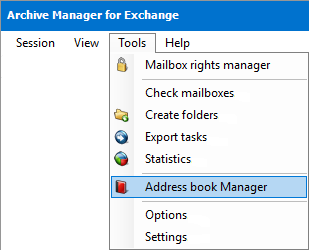


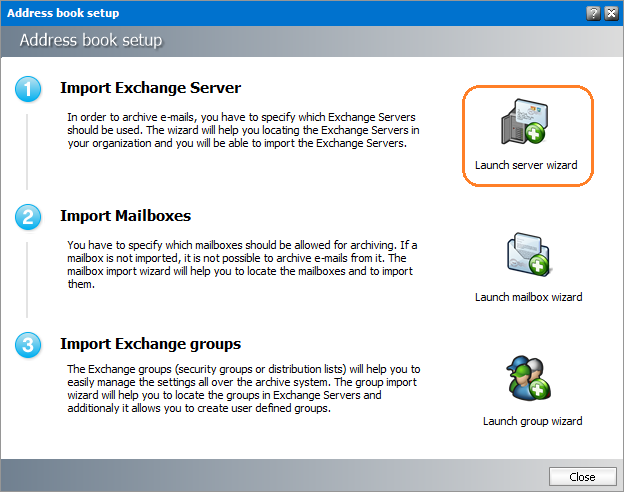

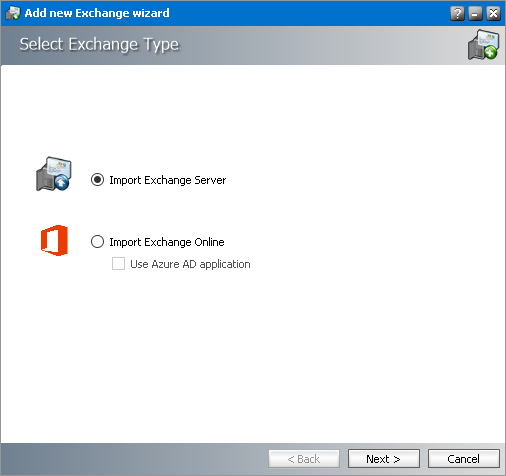


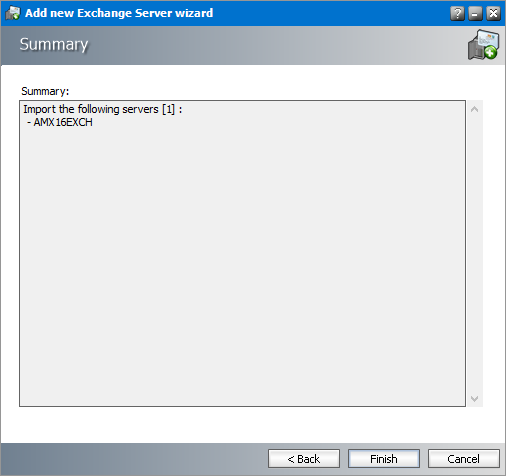


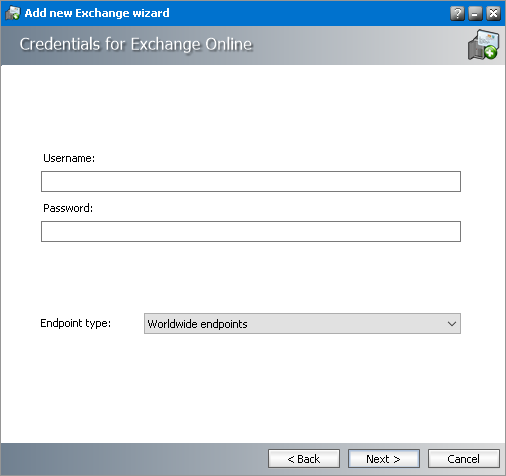


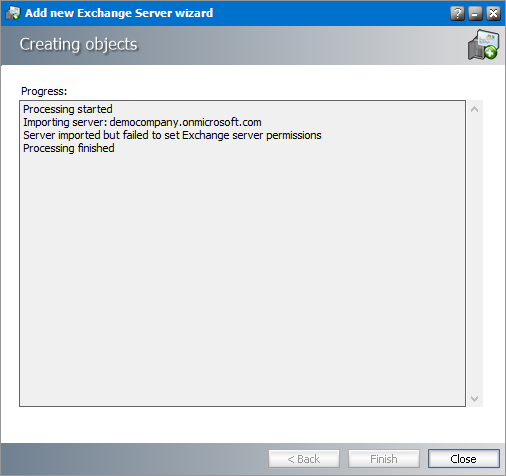
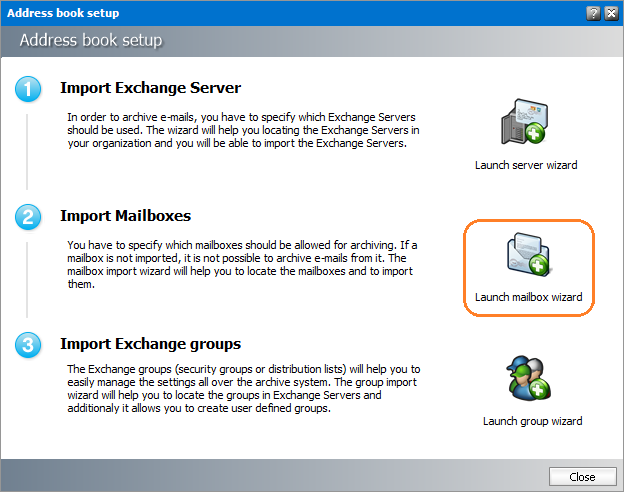


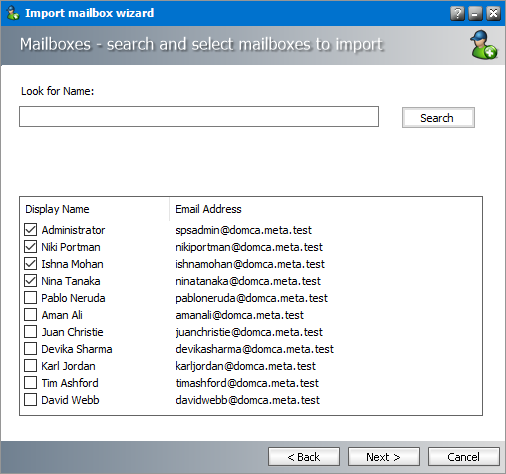

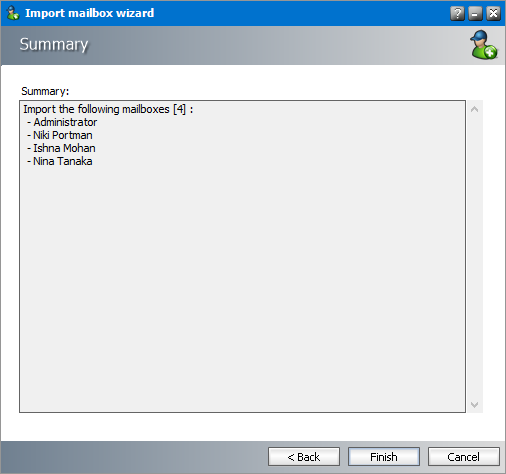

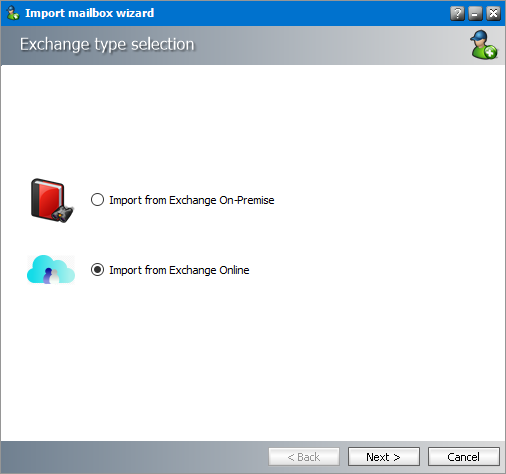

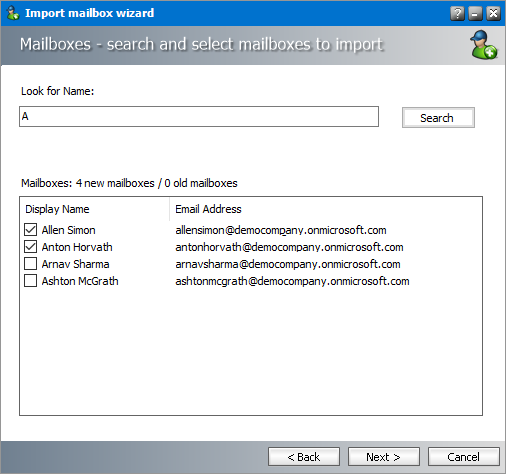
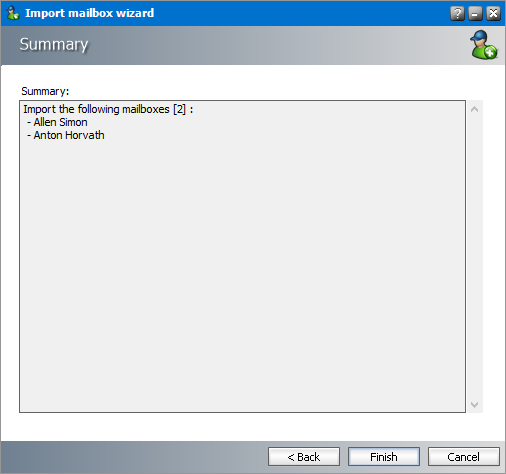


 so that you can distinguish them faster. Imported mailboxes must be added to a group in Address Book Manager to allow automatic archiving with scheduled jobs. If you do not add mailboxes to a group you can archive them manually.
so that you can distinguish them faster. Imported mailboxes must be added to a group in Address Book Manager to allow automatic archiving with scheduled jobs. If you do not add mailboxes to a group you can archive them manually.